Accepted Scientific Name: Cycas siamensis
Bot. Zeitung (Berlin) 21: 334. 1863
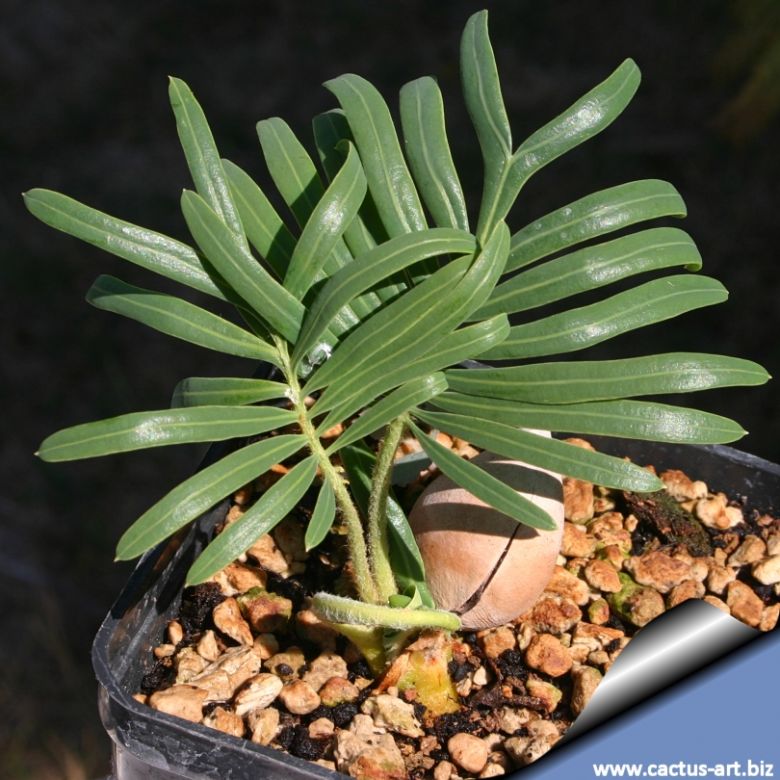
Cycas siamensis '' silver form '' Photo by: Cactus Art
(2 years old seedling) The rare silver form of Cycas siamensis is a very striking plant, both glinting and elegantly characterized by its emergent leaves that are more silvery-grey than the standard species. The leaves retain much of this colouring over time. However the young seedlings are dark green in colour for some years.
Origin and Habitat: Central Thailand and Vietnam. Also recorded from Laos, Cambogia and Myanmar (Burma).
Habitat: It is a widespread and locally extremely abundant species, it is found in many places in dry open deciduous forest on poor rocky soil to 1200 m. This species occurs in full sun to light shade on flat country or on low hills, often in dense stands. These woodlands are characteristically seasonally wet and dry with the monsoon weather patterns of the region, with particularly pronounced and extended dry periods.
Synonyms:
See all synonyms of Cycas siamensis
back
Accepted name in llifle Database:Cycas siamensis Miq.Bot. Zeitung (Berlin) 21: 334. 1863Synonymy: 7
back
Description: The typical Cycas siamensisSN|11194]]SN|11194]] is is a short stemmed, unisexual, dioecious, palm-like plant with a swollen trunk and an attractive crown. The leaves (fronds) are pinnately compound, with a very short petiole and basal leaflets gradually reducing in size towards the spines. They also differ in being usually densely brown-tomentose, with the tomentum persisting around their bases and on the trunk around the persistent leaf-bases. Plants vary in colour from white through yellow, orange to brown, depending on the colour of the hairs on the leaves. There are no other clear distinguishing features, and they must all be regarded as the same species. The seeds are yellow to orange.
Silver form: Plants with dense silver woolly hairs on the leaves are often sold as "Silver" or "Thai Silver" form. Their emergent leaves are silver in colour. The white colour comes not from a lack of chlorophyll but from fine white hairs that cover the new fronds. As they mature a lot of the hairs are lost but the plant still looks very silvery white. However the young seedlings are dark green in colour for some years. They are some absolutely stunning cycads, but, unfortunately, they are incredibly expensive at any sort of a decent size.
Flowers: Male cones are small of a distinct oblong shape, orange to brown, 10-24 cm long, 5-7.5 cm diam.
Seeds: Subglobose: 30-37 mm long, 26-37 mm wide.
Subspecies, varieties, forms and cultivars of plants belonging to the Cycas siamensis group
 Cycas siamensis Miq.: is a short stemmed cicads with densely brown-tomentose megasporophylls. Plants vary in colour from white through yellow, orange to brown, depending on the colour of the hairs on the leaves. The seeds are yellow to orange. Distribution: Thailand, Vietnam, Laos, Cambodia, Myanmar (Burma).
Cycas siamensis Miq.: is a short stemmed cicads with densely brown-tomentose megasporophylls. Plants vary in colour from white through yellow, orange to brown, depending on the colour of the hairs on the leaves. The seeds are yellow to orange. Distribution: Thailand, Vietnam, Laos, Cambodia, Myanmar (Burma). Cycas siamensis '' silver form '': has emergent leaves more silvery-grey than the standard species. The leaves retain much of this colouring over time. Distribution: Thailand, Vietnam, Laos, Cambogia and Myanmar (Burma).
Cycas siamensis '' silver form '': has emergent leaves more silvery-grey than the standard species. The leaves retain much of this colouring over time. Distribution: Thailand, Vietnam, Laos, Cambogia and Myanmar (Burma).
Bibliography: Major references and further lectures
1) Boris Lariushin “Cycadaceae Family” Lulu.com
2) Shiu-ying Hu “Food Plants of China” Chinese University Press, 2005
3) Whitelock, Loran M., "The Cycads", Timber press, 2002.
4) Nguyen, H.T. 2010. Cycas siamensis. The IUCN Red List of Threatened Species. Version 2015.2. <www.iucnredlist.org>. Downloaded on 28 August 2015.
5) Haynes J.L, "World List of Cycads: A Historical Review", IUCN/SSC Cycad Specialist Group, 2012.
6) Osborne, R.; Hill, K.D.; Nguyen, H.T. & Phan Ke, L. “Cycads of Vietnam.” Osborne, Brisbane (Australia) and Eeden, Capre Town (South Africa) 2007.
7) Jones, D. L. "Cycads of the world." Smithsonian Institution Press, Washington, DC 2002.
8) Umberto Quattrocchi “CRC World Dictionary of Medicinal and Poisonous Plants: Common Names, Scientific Names, Eponyms, Synonyms, and Etymology” (5 Volume Set) CRC Press, 03 May 2012
9) The Cycad Pages “Cycas siamensis” Royal Botanic Gardens Sydney Written and maintained by Ken Hill 1998-2010 Maintained by Leonie Stanberg and Dennis Stevenson 2010-2012 <http://plantnet.rbgsyd.nsw.gov.au/cgi-bin/cycadpg?taxname=Cycas+siamensis> Web. 25 August 2015
10) Joseph Seckbach "Symbiosis: Mechanisms and Model Systems" Springer Science & Business Media, 31 May 2002
11) Hsuan Keng, Ro-Siu Ling Keng “The Concise Flora of Singapore: Gymnosperms and Dicotyledons” Volume 1 NUS Press, 1990
12) American Florist, Volume 11, 1896
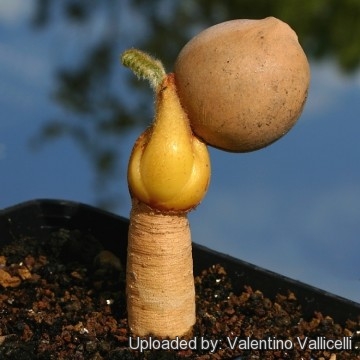 A germinating seedling showing the strong tap root. Photo by: Valentino Vallicelli
A germinating seedling showing the strong tap root. Photo by: Valentino Vallicelli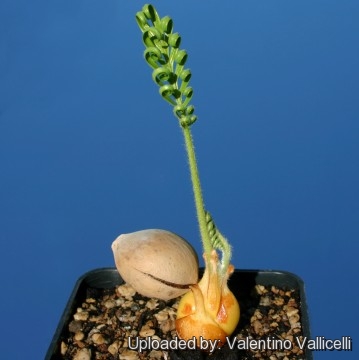 The first leaf. Photo by: Valentino Vallicelli
The first leaf. Photo by: Valentino Vallicelli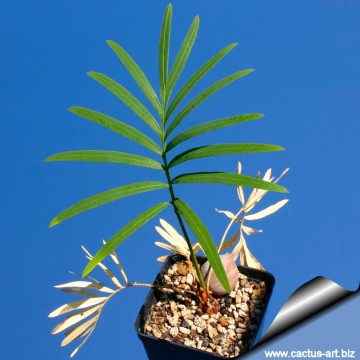 Cycas siamensis '' silver form '' Photo by: Cactus Art
Cycas siamensis '' silver form '' Photo by: Cactus Art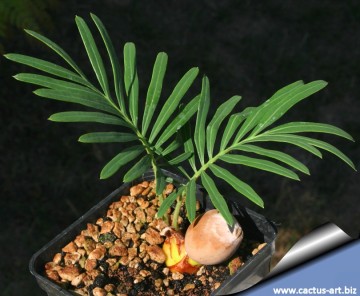 The leaves are annually deciduous, the older gradually fade as the fresh start growing. Photo by: Cactus Art
The leaves are annually deciduous, the older gradually fade as the fresh start growing. Photo by: Cactus Art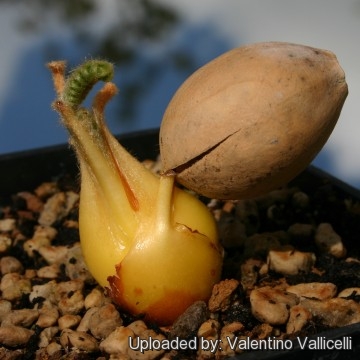 Cycas siamensis '' silver form '' Photo by: Valentino Vallicelli
Cycas siamensis '' silver form '' Photo by: Valentino VallicelliSend a photo of this plant.The gallery now contains thousands of pictures, however it is possible to do even more. We are, of course, seeking photos of species not yet shown in the gallery but not only that, we are also looking for better pictures than those already present.
Read More... Cultivation and Propagation: Ideal for the tropical to warm temperate garden and particularly adapted to pot culture, it requires partial sun and a well drained soil. In cultivation, at least in cooler climates, it is one of the few deciduous cycads, losing its leaves every winter. Coming as it does, from areas with high annual rainfall, it requires a plentiful supply of water and should never be allowed to dry out, but eventually it could stay dry for a long time. it's a bit fastidious for this climate- prefers it wetter and warmer (In temperate climate the plant might be treated like a succulent and kept rather dry and cool during the winter).
Propagation: Easy to germinate.
Warning: All parts of this plant are highly toxic, but rarely eaten due to poor flavour.














